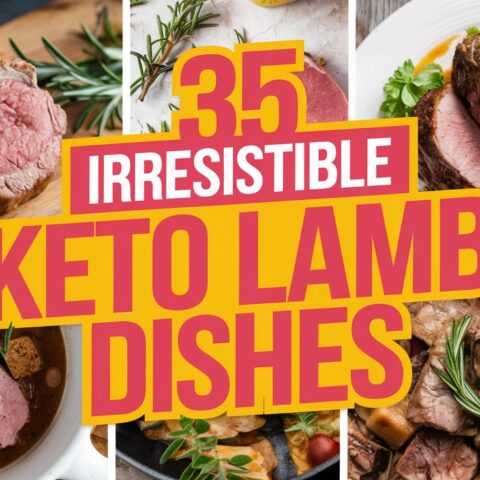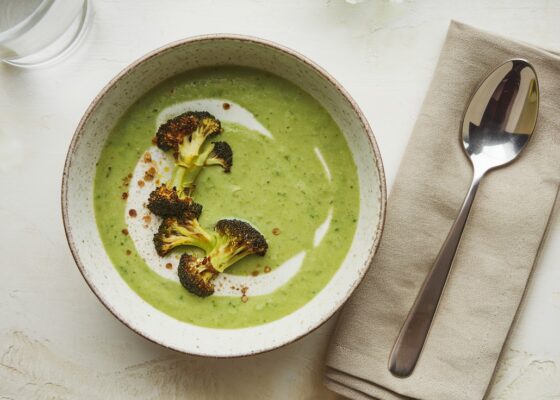
Tapioca starch is not low-carb, containing approximately 88% pure carbohydrates with 36 grams per ounce. This gluten-free thickener, derived from cassava root, has a high glycemic index of 70-90 and can cause significant blood sugar spikes. While it excels as a thickening agent in sauces and Asian desserts, it provides minimal nutritional value beyond carbohydrates. A newer variant, resistant tapioca starch, offers promising alternatives for those seeking better blood sugar management and gut health benefits.
Key Takeaways
- Tapioca starch is not low-carb, containing approximately 88% pure carbohydrates with 36 grams of carbs per ounce.
- Being primarily carbohydrates with negligible protein and fat, tapioca starch is considered a source of empty calories.
- The glycemic index of 70-90 means tapioca starch can cause rapid blood sugar spikes after consumption.
- Resistant tapioca starch offers a lower-carb alternative, causing smaller blood glucose increases and functioning similarly to dietary fiber.
- For low-carb alternatives, consider almond flour, coconut flour, psyllium husk powder, or flaxseed meal instead of tapioca starch.
What Makes Tapioca Starch Different From Other Starches
While many starches share similar properties as thickening agents, tapioca starch stands out due to its unique composition and characteristics.
Derived from cassava root, this starch consists of approximately 88% pure carbohydrates, making it particularly high in carbs compared to alternatives like almond or coconut flour.
Cassava root yields a uniquely concentrated starch, packing significantly more carbohydrates than common grain-free flour alternatives.
Unlike other starches, tapioca lacks protein, fat, and fiber content, contributing to its distinctive properties in cooking and baking.
What sets tapioca starch apart is its ability to create a glossy finish in sauces without imparting additional flavors, while also excelling in gluten-free applications due to its superior moisture retention capabilities.
For those seeking lower glycemic options, modified resistant tapioca starch offers an alternative that may have less impact on blood sugar levels.
Regular vs. Resistant Tapioca Starch Explained
Understanding the difference between regular and resistant tapioca starch is essential for those monitoring their carbohydrate intake. Regular tapioca starch contains approximately 36 grams of carbs per ounce, making it a high-carbohydrate ingredient that can greatly impact blood glucose levels.
In contrast, resistant tapioca starch offers a unique alternative due to its molecular structure, which prevents complete digestion in the small intestine. This characteristic results in lower blood glucose responses and provides additional health benefits, including improved gut health and increased feelings of fullness.
While resistant tapioca starch contains fewer digestible carbohydrates than its regular counterpart, it should still be consumed in moderation within low-carb dietary frameworks. This distinction is particularly important for individuals following ketogenic or other carbohydrate-restricted eating plans.
Carbohydrate Content and Glycemic Impact
Traditional tapioca starch contains significant net carbs at 28 grams per ounce, with clinical blood sugar response testing revealing a remarkably high glycemic index between 70-90.
The substantial carbohydrate content triggers rapid blood glucose elevation, making it unsuitable for low-carb dietary plans.
While resistant tapioca starch offers a lower digestible carbohydrate profile, regular tapioca starch remains mainly high in carbs, with one cup of tapioca pearls containing approximately 135 grams of carbohydrates.
Net Carbs Per Serving
Tapioca starch packs a substantial carbohydrate punch, containing approximately 28 grams of net carbs per 1-ounce serving.
Unlike some other starches, tapioca contains virtually no fiber to offset its carbohydrate content, resulting in net carbs that closely match its total carbohydrate count.
While the regular form of tapioca starch can notably impact blood sugar levels, resistant tapioca starch offers a modified alternative with fewer digestible carbohydrates.
For those monitoring their carbohydrate intake, it's essential to note that tapioca starch contributes its net carbs without any added sugar, making it a pure starch source.
When incorporating tapioca starch into recipes, careful portion control becomes vital, as even small amounts can considerably increase a dish's total carbohydrate content.
Blood Sugar Response Testing
The relationship between carbohydrate consumption and blood sugar levels becomes clear through scientific testing of tapioca starch's glycemic impact. Standard tapioca starch demonstrates a glycemic index of approximately 70, indicating its potential to cause significant blood sugar spikes after consumption.
Research has revealed important distinctions between different forms of tapioca starch. While traditional tapioca starch can lead to substantial blood sugar increases, resistant tapioca starch shows markedly different results.
Testing has documented only a 22-point rise in blood glucose levels with resistant tapioca starch, and continuous glucose monitoring confirms stable levels for up to 90 minutes post-consumption. These findings suggest that resistant tapioca starch may be a more suitable option for individuals concerned about maintaining steady blood sugar levels while still incorporating tapioca-based products into their diet.
Resistant Vs Regular Starch
Understanding the distinction between resistant and regular tapioca starch reveals significant differences in both carbohydrate content and glycemic impact.
While regular tapioca starch contains approximately 88 grams of carbohydrates per 100 grams and can cause significant blood sugar spikes, resistant starch offers a more moderate glycemic impact.
- Regular tapioca starch is highly digestible and rapidly converts to glucose.
- Resistant starch resists complete digestion, leading to more stable blood sugar levels.
- The higher proportion of resistant starch may support improved gut health.
The key difference lies in their digestibility and metabolic effects.
Regular tapioca starch quickly breaks down into glucose, while resistant starch undergoes a slower digestive process, resulting in gentler blood sugar fluctuations and potential health benefits beyond basic nutrition.
Health Benefits and Potential Drawbacks
While examining the health implications of this popular starch, consumers should weigh both its beneficial and potentially problematic effects. Regular tapioca starch presents challenges for those following low-carb diets due to its high carbohydrate content and minimal nutritional value. Despite potential health benefits from resistant starch properties, including improved gut health and blood sugar regulation, the standard form can cause rapid glucose spikes.
| Aspect | Benefits | Potential Drawbacks |
|---|---|---|
| Blood Sugar | May contain resistant starch | Rapid glucose spikes |
| Nutrition | Gluten-free alternative | Limited nutrients |
| Digestive Health | Could support gut bacteria | High carb content |
Moderation remains essential, as excessive consumption can lead to unwanted carbohydrate intake without providing substantial nutritional benefits, particularly for those managing diabetes or following ketogenic diets.
Common Uses in Keto and Low-Carb Cooking
Given its high carbohydrate content, tapioca starch presents significant challenges for those following ketogenic or low-carb diets. Yet creative cooks have found strategic ways to incorporate small amounts of this ingredient into their recipes.
The emergence of resistant tapioca starch has particularly expanded options for low-carb cooking, offering similar functional benefits with potentially less impact on blood sugar levels. It's important to avoid refined carbohydrates such as white bread and white pasta when incorporating tapioca starch into a low-carb diet.
Common applications in keto-friendly recipes include:
- Using minimal amounts as a thickening agent for gravies and sauces
- Combining with almond flour in gluten-free baking to improve texture
- Adding small quantities as a binding ingredient in meat-based dishes
While traditional tapioca starch requires careful portioning to maintain ketosis, its resistant variant provides more flexibility for those seeking to enhance their low-carb culinary creations without compromising dietary goals.
Blood Sugar Response to Tapioca Products
Research demonstrates that consuming traditional tapioca starch leads to significant blood glucose increases, with typical readings showing notable elevations within hours of consumption.
Studies specifically examining resistant tapioca starch reveal a more moderate blood sugar response, characterized by a 22-point rise that maintains stability rather than sharp spikes.
These findings highlight the importance of glucose monitoring when incorporating tapioca products into one's diet, particularly for individuals following low-carb eating plans or managing diabetes.
Glucose Monitoring Test Results
Thorough glucose monitoring tests reveal distinct differences between resistant and standard tapioca starch consumption patterns.
Research shows that resistant tapioca starch produces a moderate 22-point bump in blood glucose levels, maintaining stability for 90 minutes post-consumption, unlike standard tapioca starch's more dramatic impact.
- Resistant tapioca starch demonstrates a controlled glucose response, making it potentially suitable for low-carb dietary needs.
- Blood glucose levels remained consistent for 1.5 hours after consuming resistant tapioca starch.
- Baked goods made with resistant tapioca starch exhibited firmer, more bread-like textures compared to standard versions.
These findings suggest that resistant tapioca starch may offer a viable alternative for those seeking to maintain stable blood sugar levels while still enjoying certain baked products.
Additional testing with various brands will further clarify its applications and effects.
Spike vs. Stable Response
Blood sugar responses to tapioca products vary considerably between traditional and resistant varieties.
While traditional tapioca starch can trigger significant blood glucose increases due to its high carbohydrate content, resistant tapioca starch demonstrates more favorable characteristics for those following low-carb diets.
Testing revealed that resistant varieties caused only minor fluctuations in blood glucose levels, with one study showing a modest 22-point increase when consumed in truffle form.
The stability of blood glucose levels following resistant tapioca starch consumption is particularly remarkable, maintaining steady levels for approximately 90 minutes after ingestion.
This extended period of stability suggests that resistant tapioca starch could be a more suitable option for individuals seeking to manage their blood sugar levels effectively, though additional research across different brands remains necessary for thorough understanding.
Alternatives for Low-Carb Baking
When seeking alternatives to tapioca starch for low-carb baking, several nutritious options can effectively replicate the desired texture and binding properties while maintaining a lower carbohydrate profile.
The most successful approach involves combining different low-carb flours to achieve ideal results in baked goods.
Blending multiple low-carb flour alternatives creates superior texture and results compared to relying on a single substitute ingredient.
- Almond flour and coconut flour blend – Creates a balanced texture while keeping carbs low
- Psyllium husk powder – Adds moisture and bulk with minimal net carbs
- Flaxseed meal – Provides essential fiber and helps with binding
For best results in low-carb baking, these alternatives can be used in combination, offering better texture and flavor than single-ingredient substitutions. Almond flour is a popular choice due to its nutritional benefits, such as being rich in healthy fats and vitamin E, which contribute to moisture and nutrition in baking. While resistant tapioca starch may be used occasionally, focusing on these lower-carb options helps maintain dietary goals while still enjoying baked treats.
Processing Methods and Their Effects
The processing of tapioca starch involves multiple stages, beginning with the grinding of cassava root and progressing through washing, filtering, and drying steps that concentrate its carbohydrate content to nearly 90%.
During manufacturing, the starch molecules undergo structural modifications that affect their digestibility and glycemic response, particularly in the production of resistant tapioca starch variants.
These processing methods directly influence the nutritional profile of the final product, with standard tapioca starch remaining high in digestible carbohydrates while modified versions may offer lower net carb counts through altered molecular arrangements.
Manufacturing Steps and Stages
Manufacturing tapioca starch involves several precise steps that transform raw cassava root into a refined powder of concentrated carbohydrates. The process begins with selecting one large batch of fresh cassava roots, which are then thoroughly cleaned and peeled to remove any impurities.
- Washing and grinding: Fresh roots are cleaned and ground into a fine paste, similar to white flour consistency.
- Extraction and separation: The ground paste is mixed with water, and the starch is separated from fiber through filtration.
- Drying and processing: The extracted starch solution is dried under controlled conditions, leaving only a small amount of moisture.
The resulting powder undergoes quality testing to verify proper starch content and texture before being packaged for distribution.
This careful processing creates a pure carbohydrate product ideal for various culinary applications.
Chemical Structure Changes
Throughout extensive processing stages, raw cassava undergoes significant chemical structure modifications that transform its natural starch composition into refined tapioca starch.
The extraction process isolates starch granules from the cassava root, resulting in a product that remains high in carbohydrates, containing approximately 88 grams per 100-gram serving.
During processing, the application of specific heating and cooling methods can convert regular tapioca starch into resistant starch, which exhibits different properties from its original form.
This transformation can potentially alter how the body processes the carbohydrates, though the overall carbohydrate content remains unchanged.
The modified chemical structure also enhances the starch's ability to absorb water and function as a thickening agent when heated.
Nutritional Impact Assessment
Processing methods greatly influence the nutritional profile of tapioca starch, mainly affecting its digestibility and glycemic response in the body. For those who need to know, tapioca starch contains approximately 88% carbohydrates, making it pretty close to pure starch.
Understanding its impact on nutrition is vital for dietary planning, particularly for those monitoring carbohydrate intake.
- Standard tapioca starch processing retains high carbohydrate content, which experts would not recommend for low-carb diets.
- Modified resistant tapioca starch offers a lower glycemic impact while maintaining functionality.
- Portion control becomes significant due to the concentrated carbohydrate content, especially in processed foods.
The minimal protein and fat content further emphasizes tapioca starch's role as a primary carbohydrate source, requiring careful consideration in dietary planning.
Nutritional Profile and Macronutrients
An examination of tapioca starch's nutritional composition reveals its mainly carbohydrate-based nature, containing approximately 88 grams of carbohydrates per 100 grams of product.
This starch provides significant calories while offering minimal nutritional benefits, as it contains negligible amounts of protein and fat, making it a source of empty calories rather than a nutrient-dense food.
When processed into tapioca pearls, the carbohydrate content becomes even more concentrated, with one cup of dry pearls providing approximately 544 calories, primarily from carbohydrates.
This macronutrient profile positions tapioca starch as a high-carbohydrate ingredient that requires careful consideration in dietary planning, particularly for individuals following carbohydrate-restricted eating patterns or those monitoring their caloric intake.
Research on Resistant Starch Properties
While traditional tapioca starch contains high levels of digestible carbohydrates, scientific research has identified a distinct form called resistant tapioca starch that behaves differently in the body.
Studies indicate this specialized form exhibits properties that make it particularly valuable for low-carb diets and metabolic health improvement.
Resistant tapioca starch stands out as a valuable dietary component, offering distinct advantages for metabolic wellness and carbohydrate-conscious eating plans.
Key findings from research on resistant tapioca starch include:
- It bypasses digestion in the small intestine, functioning similarly to dietary fiber.
- Its consumption leads to improved insulin sensitivity and better blood glucose control.
- The starch promotes satiety, potentially supporting weight management goals.
These properties make resistant tapioca starch a promising ingredient for those seeking to maintain stable blood sugar levels while following a low-carb lifestyle, though researchers continue to investigate its full range of metabolic benefits.
Best Practices for Using Tapioca Starch
When working with tapioca starch, precise measuring techniques and proper storage methods are essential for achieving consistent results in recipes.
For ideal shelf life, tapioca starch should be stored in an airtight container in a cool, dry place, where it can maintain its quality for up to two years.
To enhance both nutrition and texture in recipes, combining tapioca starch with alternative low-carb flours, such as almond or coconut flour, creates a balanced blend that maintains structural integrity while reducing overall carbohydrate content.
Measuring For Best Results
Proper measuring techniques play an essential role in achieving consistent results with tapioca starch. Using a kitchen scale guarantees precise measurements, as one cup of tapioca starch consistently weighs around 120 grams. For maximum accuracy and texture in recipes, sifting the starch before use eliminates clumps and promotes even distribution.
- Pre-measure tapioca starch using a kitchen scale for accuracy, especially in recipes requiring exact proportions.
- Sift the measured starch through a fine-mesh strainer to remove any lumps.
- Mix the measured starch with cold liquid before adding to hot mixtures to prevent clumping.
When substituting tapioca starch for other thickeners, maintain proper ratios by using one tablespoon of tapioca starch for each tablespoon of cornstarch or flour called for in the recipe, adjusting as needed for desired consistency.
Storage And Shelf Life
Beyond precise measurements, successful use of tapioca starch depends greatly on its storage conditions and shelf life management.
Proper storage in a cool, dry place within an airtight container is crucial to maintain quality and prevent moisture absorption that can lead to clumping.
When stored correctly, tapioca starch typically maintains its effectiveness for 1-2 years, though it's best used within six months after opening.
To maximize shelf life, keep the starch away from direct sunlight, heat, and humid conditions. Regular inspection for off odors or discoloration helps guarantee the product remains suitable for use.
While some may consider freezing as a preservation method, this practice isn't recommended as it can compromise the starch's texture and cooking properties, potentially affecting recipe outcomes.
Mix With Other Flours
Successfully incorporating tapioca starch into gluten-free baking requires strategic combinations with other flours to achieve perfect results.
When combined with high-protein alternatives like almond or coconut flour, tapioca starch enhances both texture and nutritional value in gluten-free recipes.
For best results when mixing tapioca starch with other gluten-free flours:
- Maintain a ratio of 20-30% tapioca starch to guarantee proper moisture retention and chewiness.
- Pair with protein-rich flours to improve structural integrity and reduce crumbliness.
- Use as a binding agent to hold ingredients together, particularly in bread and pizza crusts.
While tapioca starch proves invaluable for texture enhancement, moderation is key due to its high carbohydrate content, especially for those following low-carb dietary patterns.
Safety Considerations and Precautions
While tapioca starch serves as a versatile ingredient in many recipes, consumers should be aware of several important safety considerations before incorporating it into their diet.
The high glycemic index of tapioca starch necessitates careful moderation, particularly for individuals monitoring their blood sugar levels. Those with diabetes or similar metabolic conditions should seek medical guidance before adding this ingredient to their meals.
Individuals with cassava allergies must exercise particular caution, as tapioca starch is derived from the cassava root and could trigger adverse reactions.
Label awareness is essential when purchasing processed foods, especially gluten-free products, as tapioca starch often appears as a hidden carbohydrate source.
Being mindful of these precautions helps guarantee safe consumption while maximizing the benefits of this versatile ingredient.
Culinary Applications and Recipe Tips
The versatile nature of tapioca starch makes it an invaluable ingredient in numerous culinary applications, though careful consideration must be given to its carbohydrate content.
When incorporating tapioca starch into low-carb diets, moderation is key, as its high carbohydrate composition can affect blood sugar levels.
For best results in culinary applications, consider these essential tips:
- In gluten-free baking, combine tapioca starch with other low-carb flours to achieve desired texture while minimizing carbohydrate content.
- Use minimal amounts when thickening sauces and gravies to maintain the dish's low-carb profile.
- Consider substituting traditional tapioca starch with resistant tapioca starch in recipes where appropriate, particularly for ketogenic diet adherence.
Scientific Studies on Blood Glucose Impact
Research findings regarding tapioca starch's impact on blood glucose levels have revealed significant differences between traditional and resistant varieties, with important implications for those following low-carb dietary protocols.
Studies demonstrate that traditional tapioca starch contains approximately 88 grams of carbohydrates per 100 grams, resulting in substantial blood glucose increases.
However, resistant tapioca starch shows markedly different effects, causing only minor blood glucose elevations of around 22 points, characterized as a bump rather than a spike.
Clinical observations indicate that resistant starch maintains stable blood glucose levels for over 90 minutes post-consumption, while also promoting improved gut health and increased satiety.
These findings highlight the potential benefits of resistant tapioca starch for blood sugar management, though researchers suggest further investigation into varying effects across different product brands.
Frequently Asked Questions
Is Tapioca Starch Low Carb?
Tapioca starch contains high carbohydrates at 88g per 100g, offering minimal starch nutritional value beyond energy. Those seeking low carb alternatives should avoid it despite its gluten-free thickening benefits.
Does Tapioca Starch Spike Blood Sugar?
Tapioca starch can considerably raise blood sugar levels due to its high carbohydrate content. Studies show it causes measurable spikes in glucose levels, making it important to evaluate its health effects when consuming.
Which Starch Is Keto-Friendly?
Popular keto-friendly starch substitutes include almond flour, coconut flour, and psyllium husk powder. These alternatives work well in low carb recipes while maintaining ketosis and providing texture similar to traditional starches.
Which Is Healthier Corn Starch or Tapioca Starch?
Neither corn starch nor tapioca starch offers significant nutritional benefits. While corn starch contains fewer carbohydrates per serving, both primarily serve as thickening agents rather than healthy dietary choices.
Conclusion
Tapioca starch remains a high-carbohydrate ingredient that isn't suitable for strict low-carb or ketogenic diets. While resistant tapioca starch offers some benefits, regular tapioca starch notably impacts blood glucose levels. Those following low-carb diets should consider alternatives like almond flour or coconut flour. When used in small amounts for specific culinary purposes, tapioca starch can be incorporated into a balanced diet, but careful portion control is essential for blood sugar management.










No Comments